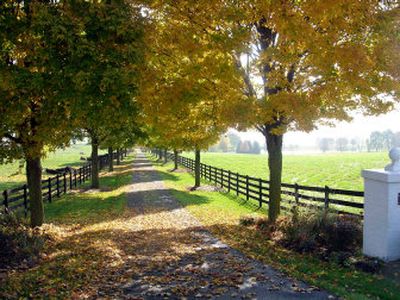Visit nursery in the fall

NEW MARKET, Va. – Do yourself a good turn when leaf-watching season arrives this year by adding nursery centers to the tour. That could mean some of the best fall colors in the area eventually coming from trees growing in your own yard.
“Many people wait until spring to buy trees so they can see how they look when they flower,” says Charles Behnke, an extension educator with Ohio State University. “They don’t think of them for the fall colors they give. But select the right weekend to visit your local garden centers so you can see them at their peak.”
Climates differ, but spring and fall generally are the preferred seasons for planting trees. The weather is cool, moisture is ample and the soil is warm or warming, giving the roots time to get established, says Lois Berg Stack, an extension specialist in ornamental horticulture with the University of Maine.
“Nearly anything that can be planted here in Maine does well if spring-planted,” Stack says. “But many plants do equally well if fall-planted. The trick comes in knowing what `fall’ is.
“We often think of fall as late September and early October, but plants only develop roots until early November here in central Maine (Orono), and most plants benefit from a rooting-in process of six to eight weeks before winter. That puts `fall planting’ back to early September.
“The best solution is to plant after the heat of summer but before it’s too late for good root development.”
Autumns in the South provide longer windows for getting new trees started. “Planting in the fall is great because we do have enough warm temperatures remaining to get some growth,” says Ken Tilt, an Alabama Cooperative Extension System horticulturist at Auburn. “By the time spring rolls around, they have a head start.”
Visiting a nursery during the height of the fall color period also can demonstrate how certain non-native cultivars will show in your area, he says. Another autumnal plus: Many nurseries are having end-of-season sales to clear their inventories. If you don’t mind a tree that may have been potted or bagged earlier in the year, then you can buy on the cheap.
“While spring is probably the best time for most planting, we all run out of time,” Stack says. “And plants are often available at very good prices in the fall. Distinguish between price and value. Quality must be factored in. I’ve fall-planted trees and shrubs with great success.”
Shopping for trees is a lot like picking out pets. Choose wisely because both are likely to be with you for a while. “Going to a garden center and asking for a `shade tree for my yard’ makes it difficult for the professionals to provide a solid recommendation. “But the gardener who does a little homework first can go to a garden center and say: `I’d like to purchase a deciduous tree. My landscape is in USDA Hardiness Zone 5A and the site has well-drained, fertile soil. I’m looking for a shade tree that will produce red fall color. The space will accommodate a mature tree of 60 feet (in height) and a 40-foot spread. I’d prefer a native plant. What would you recommend?’ That is a very easy question to answer,” she says.
One challenge in moving any plant is matching the new site with the plant’s needs. “Many gardeners select a tree based on its appearance, and then try to change the site to accommodate the tree,” Stack says. “This is difficult, especially over the time frame of a tree’s life. It’s easy to amend a site for an annual plant, but much more difficult to change a site for a tree that will live many years.”
Some other things to consider when planting trees:
Dig wide rather than deep – no deeper than the root ball. “Tree roots are shallow and they need oxygen,” Tilt says. “Most of the oxygen is in the upper layer of soil. You can slow the growth rate and even suffocate the roots by burying them too deep.”
Water liberally if you plant in the fall and add a layer of organic mulch, something like shredded bark, pine straw, leaf litter or wood chips. Layer the material in the shape of a donut, keeping it away from the tree trunk.